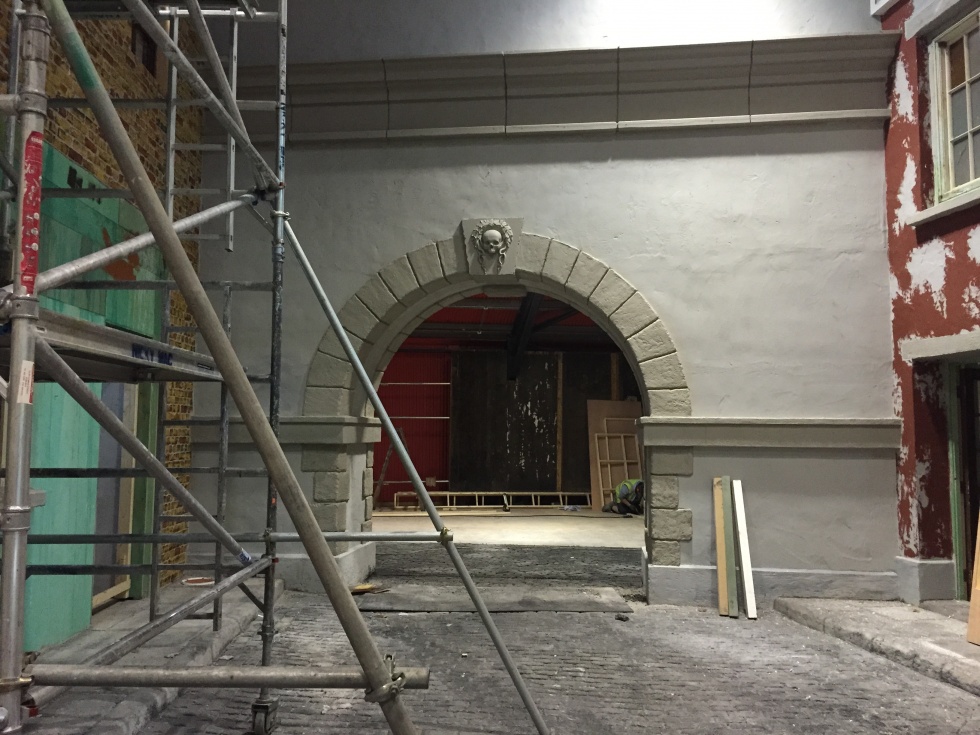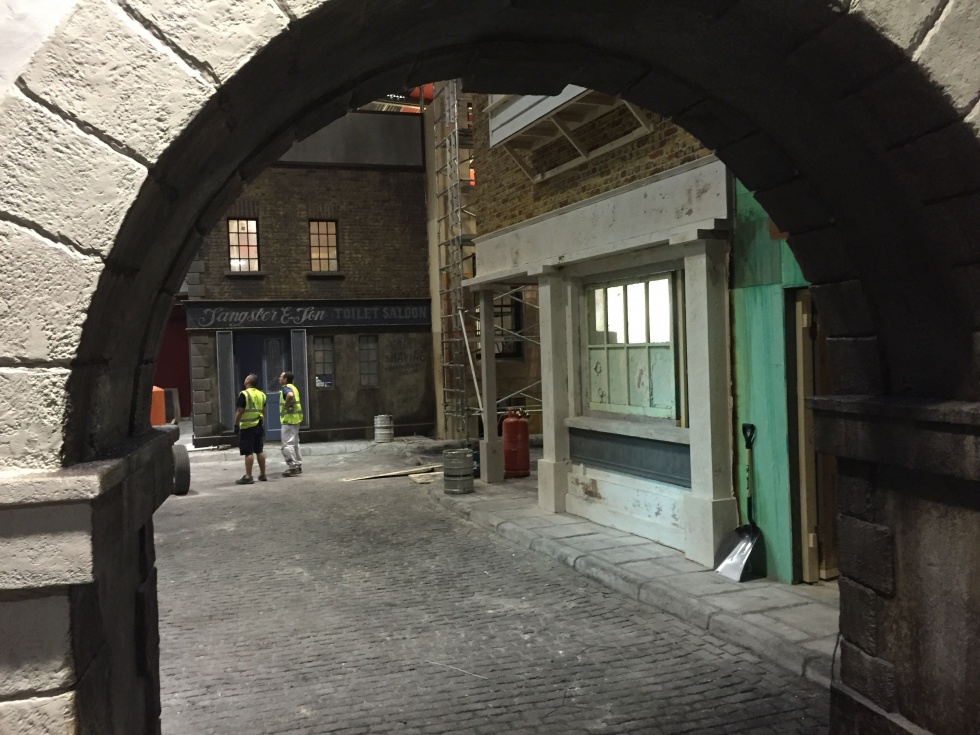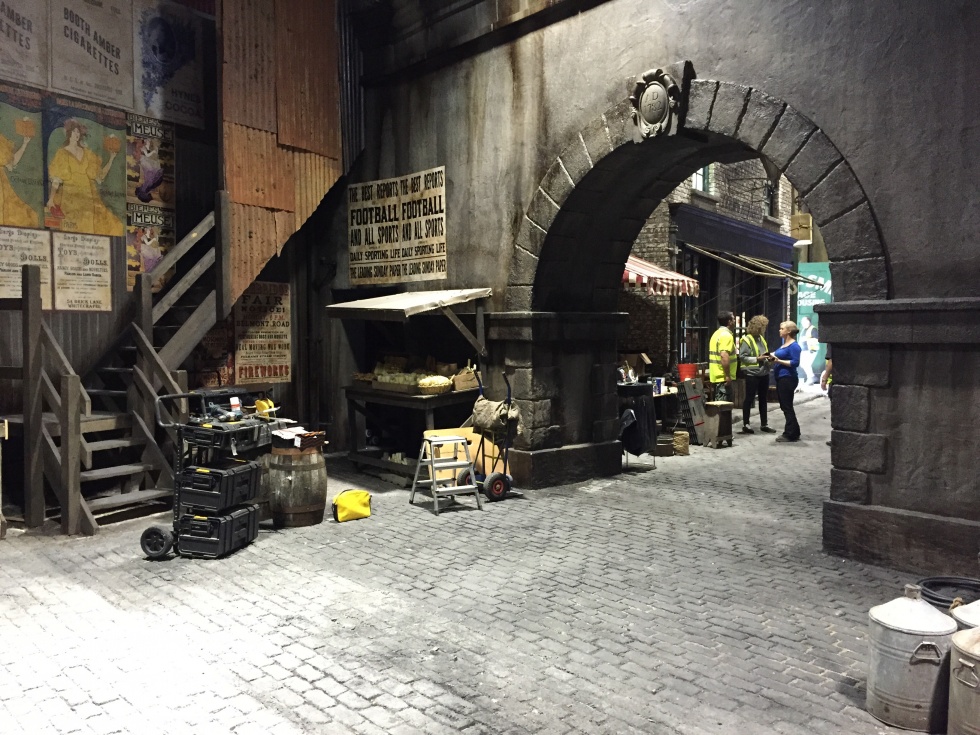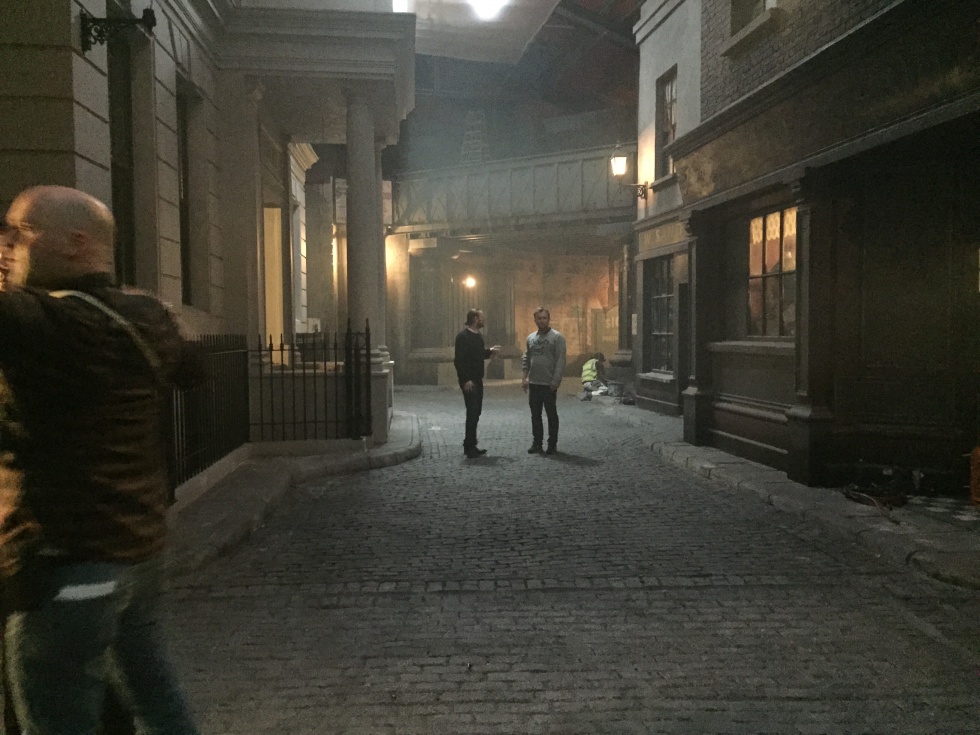He began his film and television career working in the art department on productions such as David Copperfield, Treasure Island and The Count of Monte Cristo and worked his way up to production designer on Ripper Street. Despite being busy working on the fourth series of Peaky Blinders, Stephen Daly kindly took the time to talk to me about his stay in Whitechapel and share some rare and previously unseen images…
An exclusive RIPPER STREET interview
with the production designer Stephen Daly
~~~
Copyright © Damian Michael Barcroft 2017
All images Copyright © Stephen Daly/Tiger Aspect Productions 2016
~
DAMIAN: In preparing for this interview and coming up with some questions for you, I thought about the production designs that have had the greatest impact on me over the years and came up with the following: The Cabinet of Dr. Caligari (1920: Walter Reimann, Walter Rohrig and Hermann Warm), Metropolis (1927: Otto Hunte), Alien (1979: Michael Seymour), Blade Runner (1982: Lawrence G. Paull), Batman (1989: Anton Furst), Dick Tracy (1990: Richard Sylbert) and Bram Stoker’s Dracula (1992: Thomas Sanders). These may be rather obvious choices and I apologize that they all seem to belong to either the horror, Sci-Fi or comic book genre. However, I wonder what productions have inspired you and when did you first become aware of the art of production design?
STEPHEN: Corny though it might sound (and quite a cliche for filmmakers of my generation), I first got interested when I saw Star Wars at the age of 5. I lived in the US in 1977 and although I was very young, I remember thinking “how the hell did they do that?” I had no idea what a Production Designer was or what an Art Department did, but I knew somebody made it, somehow the hyper-realistic look of the film was man-made. Over the years I’ve always collected “the art of” books and been interested in behind the scenes. I suppose I’ve always had a leaning toward Sci-Fi and Westerns in particular. I think the 70s designers like John Barry, Norman Reynolds, Dean Tavoularis, etc, brought in a new period of ‘beaten-up’ sets. Suddenly worlds became more lived-in. Theatricality was definitely out. I think the films of my childhood, the films that subconsciously affected me –Star Wars, Indiana Jones, Ghostbusters, ET, all that 70s and 80s Hollywood stuff- had this great lived-in feel. As I got older and into Scorsese, Hitchcock and Coppola, I remember noticing more how the camera moved and how it affected the sets, how colours really mattered and how a film could have a combined visual design. I also became a huge fan of Japanese movies. I think compared to a lot of Hollywood cinema, the notion of design was more obvious in a lot of Japanese stuff; big swathes of colour, epic scale, great stuff.
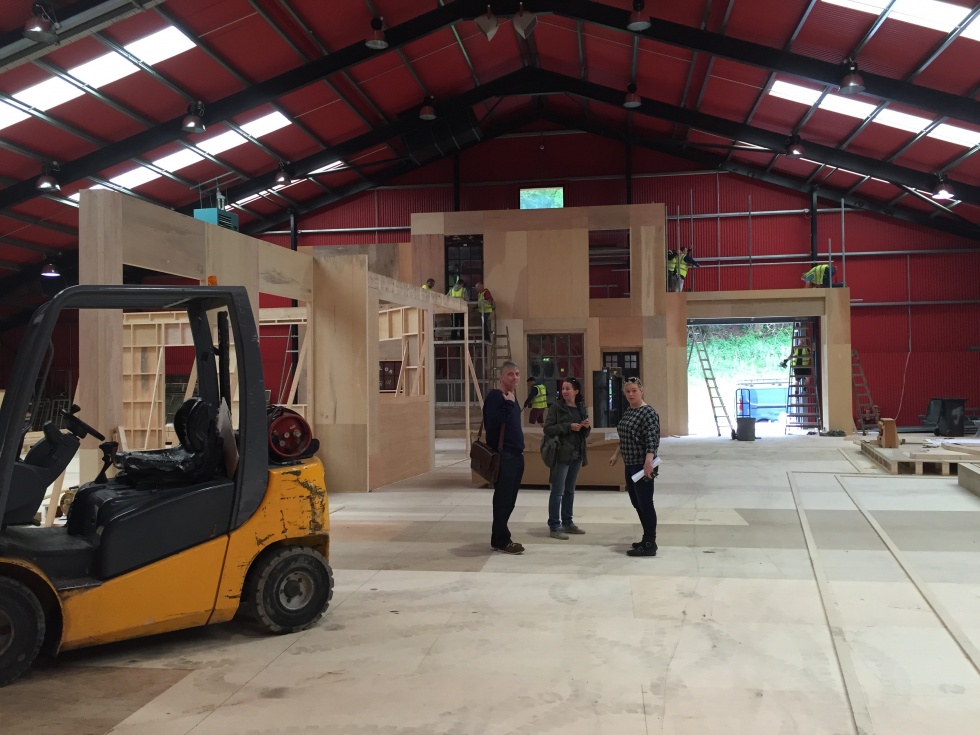
John Neligan (Set Decorator), Marion Picard (Props Buyer) and Briana Hegarty (Supervising Art Director)
DAMIAN: Can you tell me a little bit about your training and how you first came to work in the business?
STEPHEN: After I left film school, I spent a year in a place called Concorde in Galway in the middle of nowhere in the west of Ireland. Roger Corman had 3 studios at the time (mid-90s), one in the US, one in Russia and one in Ireland. I got a job with the art dept, doing anything and everything (standing by on set, designing sets, storyboarding, making props, set construction, set painting…), got paid bugger all and had a great time. It was amazing training for a young guy starting out. You really got to learn all aspects of the game and you had to think on your feet. I worked on SEVEN feature films in one year.
You can’t get better than that.
Then I became the Art trainee on a BBC TV production called Ballykissangel, which was fun. There wasn’t much to do so we would let all of the work pile up until Friday.
DAMIAN: Mark Geraghty did phenomenal work on the sixteen episodes from the first two series, was it a somewhat daunting experience for you to take over as production designer – especially on such an epic project as Ripper Street?
STEPHEN: Mark is great. I first met him on The Count of Monte Cristo, when he hired me as Assistant Art Director. I did the standby job and did the storyboards for the film. It was my first proper big job. We made the film in Ireland and Malta and I remember having a great time on the job and I think we in the art dept did some super work. Mark was amazing to work for and I learned a ton from watching him.
I don’t think I found the move to Ripper too daunting. I felt ready to move up in scale and budget. Until then I had been designing small, low-budget features and TV and really wanted to move on. Ripper came along at exactly the right time. Of course I was nervous, but I think any budding designer keen to get stuck in would relish the thought. I had seen the show and really liked it. I remember visiting the sets when they were under construction and being really impressed.
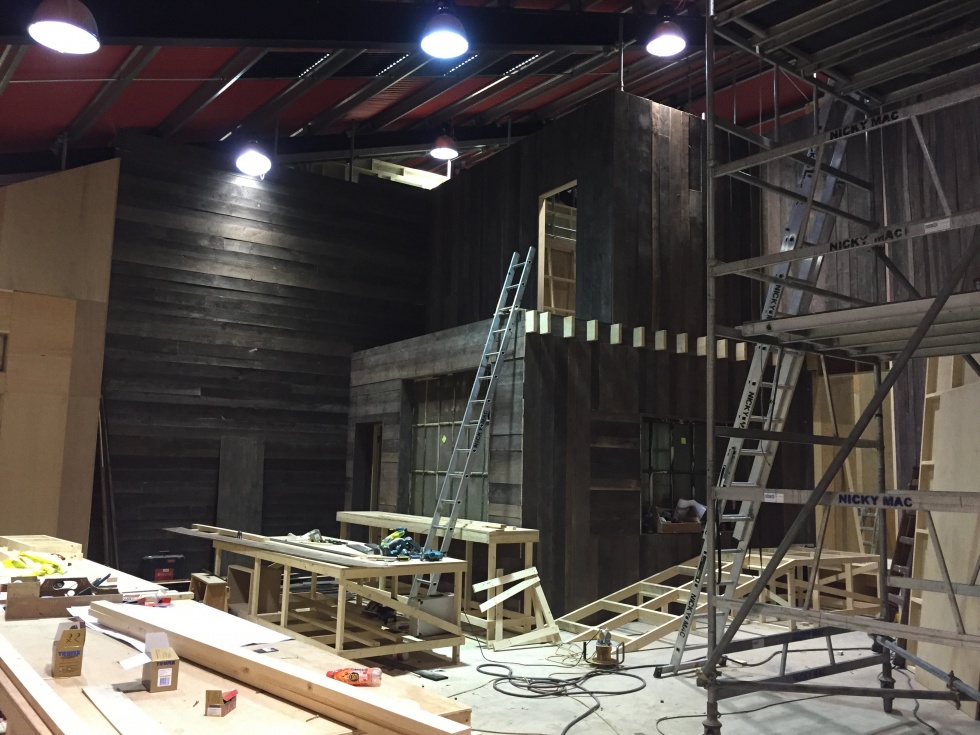 DAMIAN: Given the exquisite period detail, you must have conducted painstaking research in designing the sets with such authenticity. Were there any books or websites that you found particularly useful in helping you to visualize and then actually realize Victorian Whitechapel?
DAMIAN: Given the exquisite period detail, you must have conducted painstaking research in designing the sets with such authenticity. Were there any books or websites that you found particularly useful in helping you to visualize and then actually realize Victorian Whitechapel?
STEPHEN: The key to doing a good job, I think, is having the right crew and enough time. Thankfully, on Ripper, we had this. I had such a fantastic art dept – they really did an amazing job, all of them. I’m not sure I’d use the word ‘painstaking’, though – that makes it sound like slavery. It was very enjoyable because we had enough time (just) to do some good research and then design. It’s very important to immerse yourself in the world for a while and let it sink in. The two main sources that immediately come to mind are Gustav Dore’s drawings of Victorian London and a great book called ‘Lost London’ by Philip Davies. Obviously there were more influences, both conscious and not, but these two were a huge help. But they were both black and white. There’s not much colour reference from back then, which freed us up to choose our own palette. I like limiting the colours we will use at the start of the job (with a huge degree of flexibility) and keeping the palette simple. I think that way, the colours have a more direct impact on the viewer, whether it’s noticed or not, and therefore it underlines the mood of the story more.
DAMIAN: Presumably you see the script and then start making notes but can you take me through your pre-production process as a production designer using Ripper Street as an example?
STEPHEN: Actually, I started designing Ripper 4 and 5 before we had scripts. Richard [Warlow – series creator] and I talked about plots and so on and he told me the main beats for the series as a whole. Also, I knew it needed an old Victorian London street and a Police Station, etc, as we had done it before, so that was a help.
Normally, on a film you have a script but it’s quite common that for a TV series you might only have outlines or maybe just episode one or two. So working closely with the showrunner/writer is very important early on. The lion’s share of my work, as I see it, is in the early days, before most of the crew is on the job and way before shooting starts.
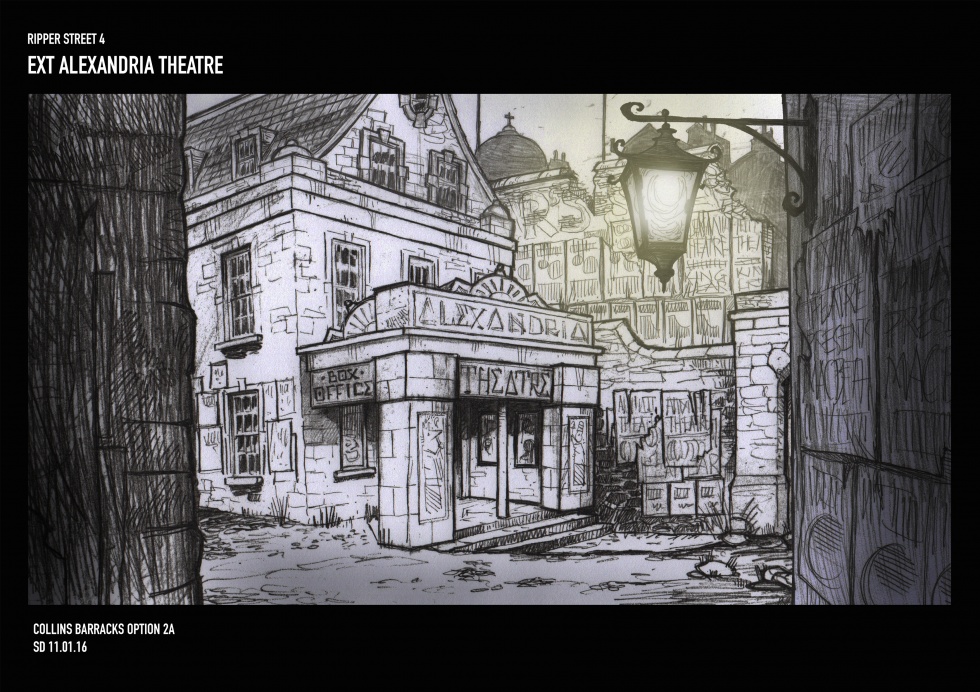 On Ripper Street series 5, I knew we needed a backstage area for the Alexandra Theatre. From talking to Richard et al, I knew we would spend a lot of time there, so it made sense to build a set. We also knew we were striking the interior of Abel Croker’s warehouse from series 4, so basically we set to work revamping Croker’s place and turning it into the theatre backstage.
On Ripper Street series 5, I knew we needed a backstage area for the Alexandra Theatre. From talking to Richard et al, I knew we would spend a lot of time there, so it made sense to build a set. We also knew we were striking the interior of Abel Croker’s warehouse from series 4, so basically we set to work revamping Croker’s place and turning it into the theatre backstage.
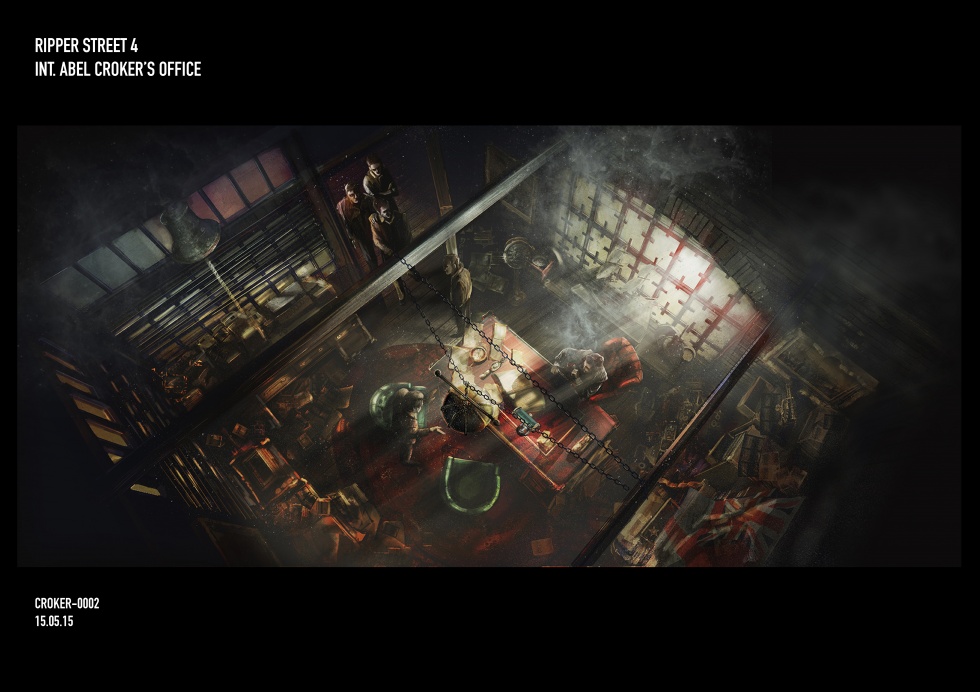
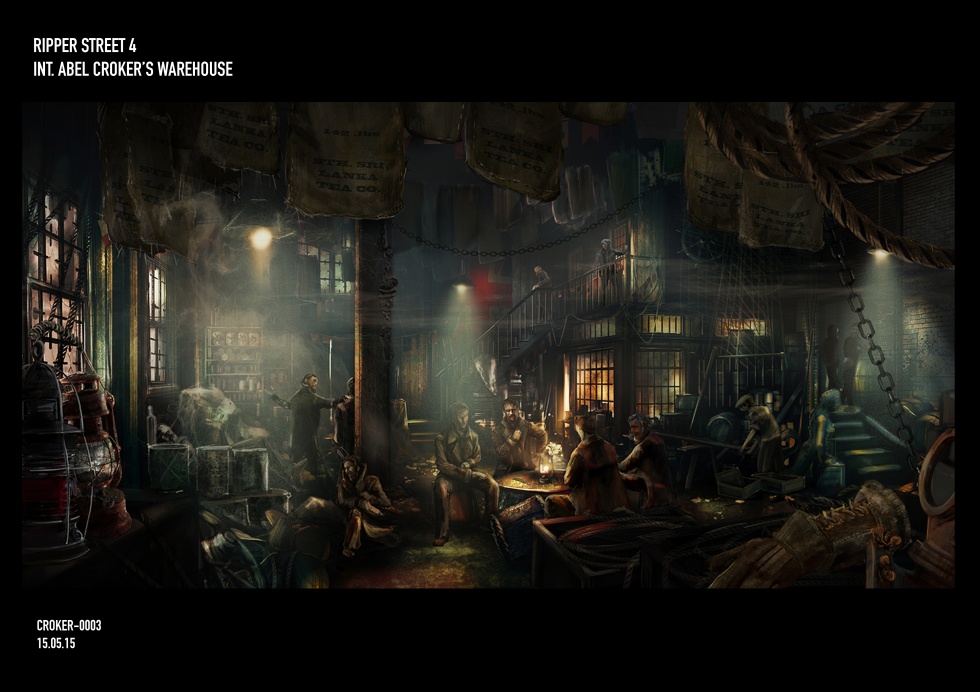 So while Briana (supervising art director), John (set decorator) and the rest of the art department were getting on with the nitty-gritty of the theatre (furnishings, wallpapers, posters, you name it), I spent a lot of time with Gordon the Location Manager figuring out how to design the shoot and find locations. I say ‘design the shoot’ because that’s what it feels like. So much of my work with the Location Manager is piecing together the sets in areas that can facilitate the shooting of the show while not compromising the look. This takes weeks and weeks of visiting places, seeing if they work for certain characters’ houses, certain beats of the script, you name it, and trying to put the jigsaw together. So we will print out pictures, slap them all up on a big wall, stand back and have a look. Also, I have to keep my budget in mind at all times. There are other balls in the air… Maybe an actor isn’t available when we want to shoot at a certain place. Maybe there are sound issues. Maybe this, maybe that… The list is a long one.
So while Briana (supervising art director), John (set decorator) and the rest of the art department were getting on with the nitty-gritty of the theatre (furnishings, wallpapers, posters, you name it), I spent a lot of time with Gordon the Location Manager figuring out how to design the shoot and find locations. I say ‘design the shoot’ because that’s what it feels like. So much of my work with the Location Manager is piecing together the sets in areas that can facilitate the shooting of the show while not compromising the look. This takes weeks and weeks of visiting places, seeing if they work for certain characters’ houses, certain beats of the script, you name it, and trying to put the jigsaw together. So we will print out pictures, slap them all up on a big wall, stand back and have a look. Also, I have to keep my budget in mind at all times. There are other balls in the air… Maybe an actor isn’t available when we want to shoot at a certain place. Maybe there are sound issues. Maybe this, maybe that… The list is a long one.
Then when we think we have something to go on, other crew members get involved. Obviously, the director has to have his tuppence-worth. He might look at a location and think, oh God that’s not what I had in mind at all (this is when I feel like a salesman, trying to convince him/her of my genius idea…). The DP needs to light it. The gaffer needs to get his gear there. The crew need access. Basically, pre-production is a huge spinning-plates session, but always, always, I have to keep the design of the show in mind.
DAMIAN: And then when it’s actually production time and the cameras are ready to roll, can you describe a typical day on set – perhaps the very first day of a shoot would be a particularly illuminating example?
STEPHEN: The only difference between the first day and any other day is that a sort of collective panic starts to descend on the whole crew about a week before. The art dept has usually been chugging along, busy as you like, for a few months by this stage, but everyone else is twiddling their thumbs, anxious to get going. So there seems to be an subconscious notion that we are shooting the entire show next Monday!
But really it’s good to start shooting, get the ball rolling it’s why we’re all here after all.
I would usually get to set first thing in the morning, check in with the director, see if it’s all OK. Then buzz about checking on locations or sets, drawing a bit back at the office. In a nutshell, we need to be ahead of the camera, so we work backwards from when we think the set will be ready, always working to the shooting schedule. Schedule changes are hell for the art dept.
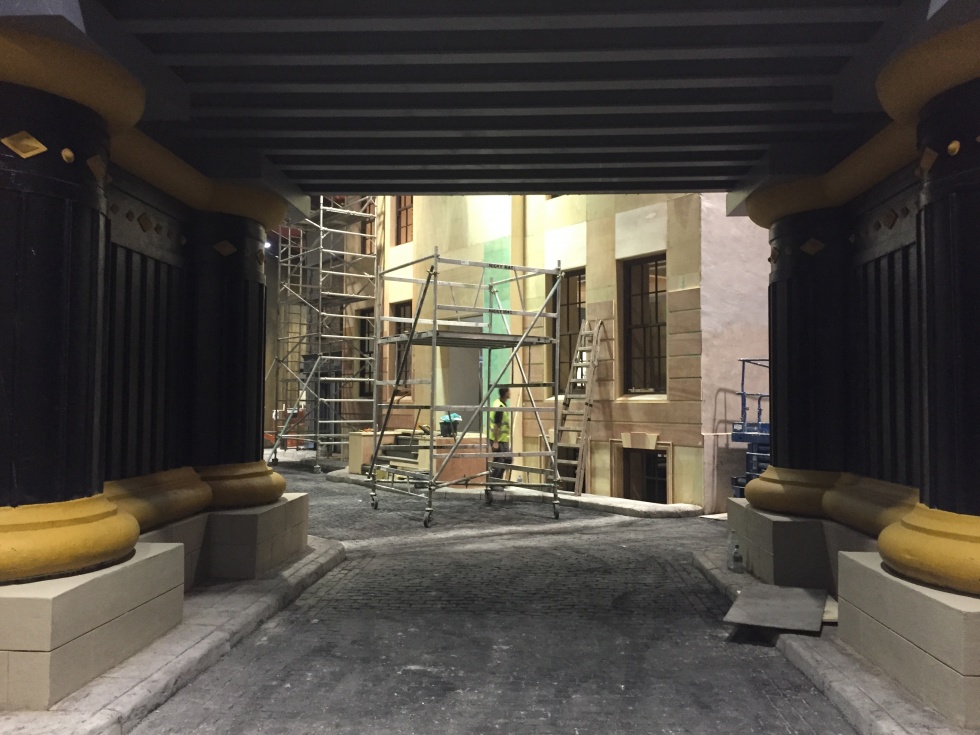 DAMIAN: How many different sets or locations might you need to prepare for an average day’s shoot?
DAMIAN: How many different sets or locations might you need to prepare for an average day’s shoot?
STEPHEN: It really depends. Sometimes we are on the same set for days on end, sometimes we might do up to seven little things on a day. However, what the script might call ‘little’, as in screen-time, still requires a great deal of work from us… no matter if it’s on screen for twenty seconds or twenty minutes, it still has to look like 1897.
DAMIAN: I think the first three series were shot at Clancy Barracks and then you moved to a disused hotel complex in Kilternan. Why the move and to what extent were you able to recycle the previous sets?
STEPHEN: The lease on Clancy was up – the site is now being developed into swanky apartments. So, Ripper needed a new home.
We looked at various options in the UK and Ireland. My favourite two options were an old cigarette factory in Liverpool and the Kilternan hotel. The Liverpool place suddenly became unavailable, so we really only had the Kilternan hotel – not that that was second best by any means. It ended up being a dream of a location and base.
We recycled what we could from before. Scaffolding, doors, windows, but really it was a build from scratch.
We built the main street set (including interiors and Croker’s warehouse) in an area that was supposed to be for indoor tennis courts. This meant we had full control of light (night/day) and weather (rain/snow).
 DAMIAN: So for series four and five there was the main set including a new police station and exteriors. Can you tell me some of the dimensions of these sets such as how high they were built and how long Leman and other streets actually were?
DAMIAN: So for series four and five there was the main set including a new police station and exteriors. Can you tell me some of the dimensions of these sets such as how high they were built and how long Leman and other streets actually were?
STEPHEN: The main ‘booking hall’ of the police station was about 40’ wide and 30’ deep. It was a big space – I always had a Wild West saloon in mind.
The main street outside was about 90’ long, and it snaked under a railway bridge at one end and ended in a t-junction at the other. One thing I was very keen on was allowing the camera/actors into the actual interior spaces. Previously, we had to cut from exterior to interior (i.e. they were two different spaces) but I really wanted it all to appear seamless. It might only have been in one or two shots, but it all added to the atmosphere of the show.
On the main street set, we built the set on two levels. You could walk around the whole thing on ground level or on the first floor. So we either used the upper level for sets (Mathilda’s window for example, or the opium den) or camera positions. We generally kept ceilings very high, about 11’ or so, so we could light from above and not worry about seeing the ceiling. If we needed it, we would add a lightweight canvas ceiling piece, called a windbag.
 DAMIAN: How long did it take to first design the sets and then to actually build them?
DAMIAN: How long did it take to first design the sets and then to actually build them?
STEPHEN: Once we had decided on the tennis court space, the design came quite quickly really. The ‘stage’ wasn’t a real stage as it had a pitched roof, unlike a proper stage with a high flat roof. I think it was 33’ tall which isn’t massive – and only in the middle. So the main run of Leman Street ran along this pitch, allowing us the full height to light it. But it meant the edges of the stage became quite cramped, where the stage ceiling was only about 16’. Along the edges we had alleyways and side-streets.
I think I had about six weeks to design and draw the main street set. Obviously I didn’t do this alone. Briana and the other art directors were busy scribbling away to have it ready for Nicky (construction manager) and his (excellent) crew. Nicky had 99% of the set done in eleven or twelve weeks, which is astonishingly quick considering the scale of the job. Eamonn (props master) and his guys started dressing it with about five weeks to go. It was all hands on deck.
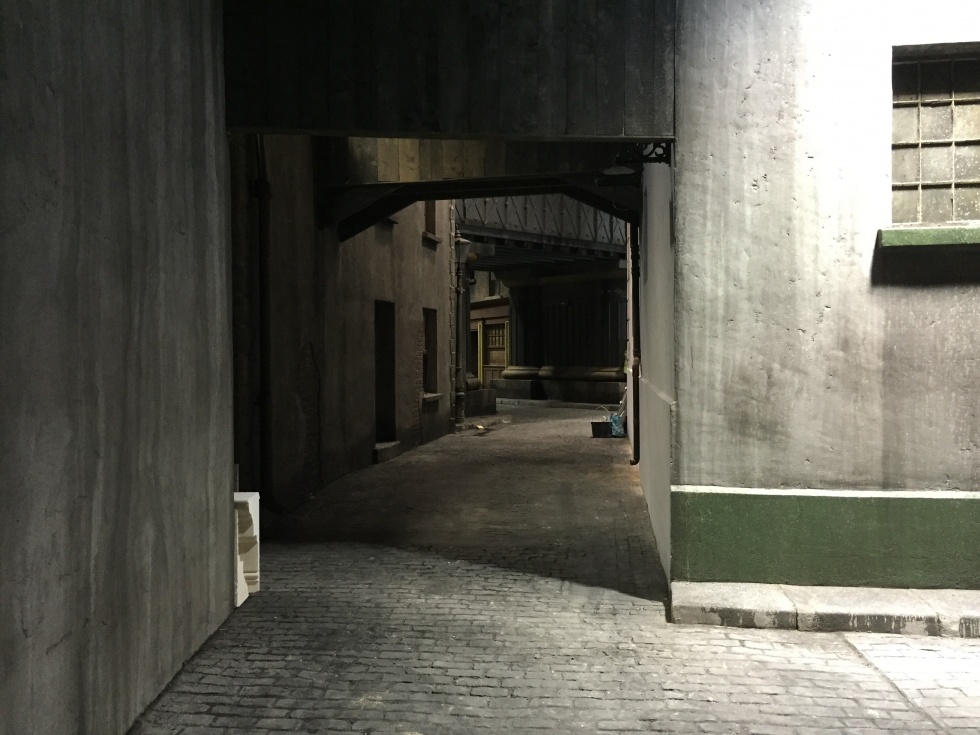 DAMIAN: Were there any particular advantages that the new sets had over the previous ones in terms of the how the directors could shoot scenes?
DAMIAN: Were there any particular advantages that the new sets had over the previous ones in terms of the how the directors could shoot scenes?
STEPHEN: As I said before, being indoors meant full control of the lighting (time of day). We were shooting in the middle of summer, but it could be night-time at the flick of a switch. So, the writers had the freedom to write night where previously we would have been limited to interior work only. I think this gave Ripper a nice grim outdoor feel.
Also, we had the freedom to shoot about five different street set-ups on the one set. With some notice, my department could prep a street for different areas of London (as long as grimy was your thing) and the crew could move around easily. It meant staying in one place, with the ease of being on a stage, without going hither and yon from location to location. We really shot a heck of a lot of stuff on the stage. Once we added computer generated skies, you’d never know it was a stage.
DAMIAN: I think most of the first two series were shot mainly on set and then you started to film on exterior locations for the last three. Do you prefer or is it easier to shoot on set rather than location work?
STEPHEN: I refer to my last answer. Actually I think it was the other way around. Not that we didn’t go on location. Of course we did. But we made a big effort to shoot on our big street set as much as possible after we had spent so much money on it!
Also elsewhere in Kilternan we had an old (early 1800s) house, which was Drake’s office, detective rooms and staircase from the police station (upstairs) and Dove’s house interiors (downstairs). We also converted the men’s changing rooms in the hotel spa into Jackson’s police lab. We even used the swimming pool there for the Thames at night. There was so much stuff. Not to mention the hundred-odd acres of golf course. It was an excellent base.
 It’s hard to say which I prefer. If you haven’t got the money, then location is the way to go. But when given the time and money (and the backing from the producers, as in this case) then building sets makes life much easier for all involved. Film-making is like hanging around with a circus 24-7, so if the circus doesn’t have to move so much, then happy days. From my point of view, if I know I have the workshop and props store right beside the stage, then last-minute ideas are actually possible, whereas if you’re off on location your planning has to be bang on.
It’s hard to say which I prefer. If you haven’t got the money, then location is the way to go. But when given the time and money (and the backing from the producers, as in this case) then building sets makes life much easier for all involved. Film-making is like hanging around with a circus 24-7, so if the circus doesn’t have to move so much, then happy days. From my point of view, if I know I have the workshop and props store right beside the stage, then last-minute ideas are actually possible, whereas if you’re off on location your planning has to be bang on.
DAMIAN: To what extent does production design necessitate a creative collaboration with other departments such as the art director, set decoration or location manager?
STEPHEN: Film-making in general is one huge collaboration – for everyone. So many departments and jobs feed off one another, you simply can’t be too precious and firm in your ideas. It’s a strange mix of knowing what you want and yet oddly being willing to bend here and there to suit whatever.
My department feeds off my ideas, but having said that, I’m by no means ‘The Boss’. I really like the idea that we are all in it together. I can’t expect people to come to work to get told what to do. I remember working like that when I was an assistant or an art director and I absolutely hated it, so I wouldn’t do it to my crew. We should enjoy it otherwise we will do bad work.
I like getting lots and lots of references, doing some key concept drawings and making sure my guys understand the world that our characters live in. That’s my job, really; I am the link from the rest of the production to the design of the film. I have to pitch my ideas to the director/producers and also listen to what they want.
Same goes for locations. The Location Manager might have an idea from reading the script that is different from mine, but that’s not to say it’s a bad idea. Just different.
Really it all goes back to prep time. If I have enough time to get lots of period reference in advance, in order to feed through to Art, Props and Locations, then we can all get on board for the ‘world’ we want to create.
Although I want to allow my crew the freedom to do their own thing, I still think the Designer’s decision should be final. If you don’t have one single vision, then it’ll look too uncoordinated, too scatty.
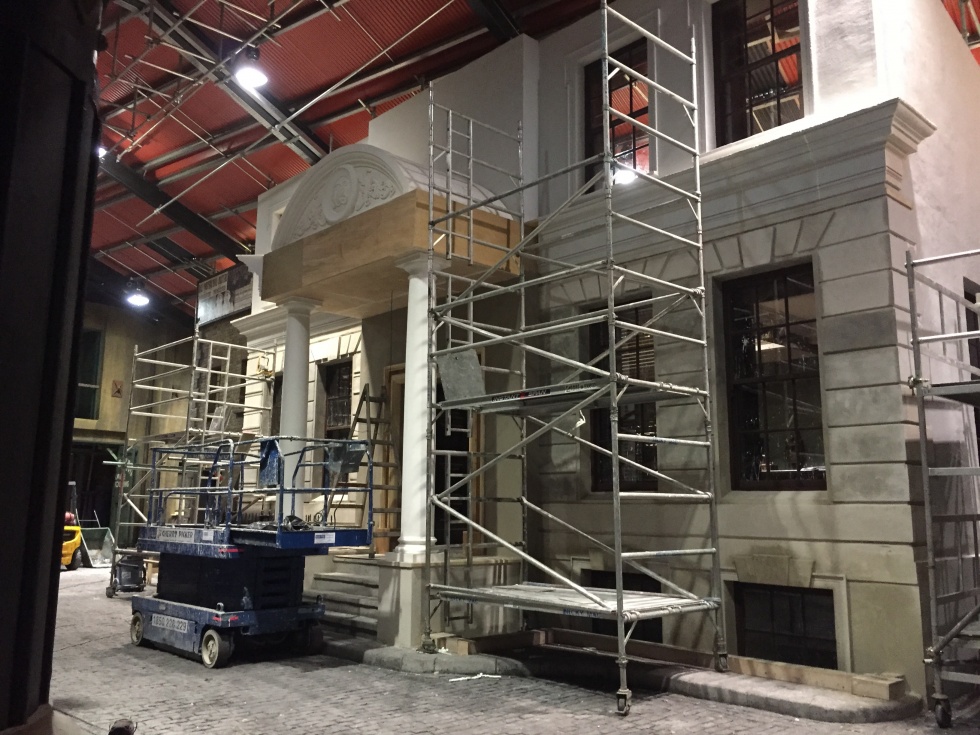 DAMIAN: And did you liaise with Ed Bruce and the visual effects team in order to provide a consistent vision that marries together the physical and virtual depictions of Whitechapel?
DAMIAN: And did you liaise with Ed Bruce and the visual effects team in order to provide a consistent vision that marries together the physical and virtual depictions of Whitechapel?
STEPHEN: Yes. absolutely. We had lots of meetings in the beginning and we would bring them in to meet us regularly or we would go to their offices. VFX is just as important as anything else for me. Ed and his guys are great. When you’re dealing with people as good as them you’re in good hands.
 DAMIAN: The first series of Ripper Street was set in 1889 and the fourth in 1897 with the fifth picking up events straight afterwards. How does your production design reflect the changes in technology during this period of Victorian history?
DAMIAN: The first series of Ripper Street was set in 1889 and the fourth in 1897 with the fifth picking up events straight afterwards. How does your production design reflect the changes in technology during this period of Victorian history?
STEPHEN: Richard is always great for adding gizmos and gimmicks in the script – a way of showing progress in the story. That’s a big help when you pick up the script in the first instance. So, like with all good scripts, you’re already thinking of what was ‘new’ back then.
I talked a lot with Leonie (costume designer). We were very conscious of the mixture of the old and the new. London was such a dump back then, so many warrens of slums and sh*t (quite literally). We wanted to show that the people in our world would add a layer of modernity, whether it’s nice clothes or fabrics in their houses, on top of the old decay that had been around for years.
I think if you show modern trends (and that’s down to research and references) on top of very old stuff, then you’re not shoving it down the audience’s throat, instead you’re bedding it into the world more realistically. I liked finding much older (sometimes Georgian) locations, or references, then dress a thin layer of Victorian lace or some patterned fabric on top. It’s really just like the world we live in today. We live with the past as much as the now.
One way I was very fixed on was showing progress in the street art, i.e. posters. As printing became cheaper (for full colour) and trends changed, we could reflect this change over the years on the streets in the background.
 DAMIAN: Fans of the show will undoubtedly remember the epic train crash that opened series three. Can you take us through the sheer logistics of designing for something that ambitious?
DAMIAN: Fans of the show will undoubtedly remember the epic train crash that opened series three. Can you take us through the sheer logistics of designing for something that ambitious?
STEPHEN: That was shot over several locations…
Carriage interior – set build on a stage in Dublin.
Train station platform – at Loughborough in England.
Trains travelling – Loughborough and surrounding area (about three locations I think).
Train crash site – at the big Whitechapel set at Clancy Barracks, Dublin.
Signal Box – Loughborough again.
Train traveling over Whitechapel – CG addition to the Clancy set.
The key to a big thing like this is to storyboard. That way everyone has a visual story in their heads first. Then we can break down each of the elements and design the shoot around each element, knowing already what has to be shot. Then the editor can reassemble the jigsaw puzzle, again working to the storyboard.
Andy (director), Jonathan (storyboard artist) and myself worked out the story of the shoot, but it meant a few weeks of Andy and I looking at various train options in the UK and seeing what would fit.
I think it probably took the bones of a week to shoot the whole thing, including the aftermath.
It was a long time ago…. I can’t really remember.
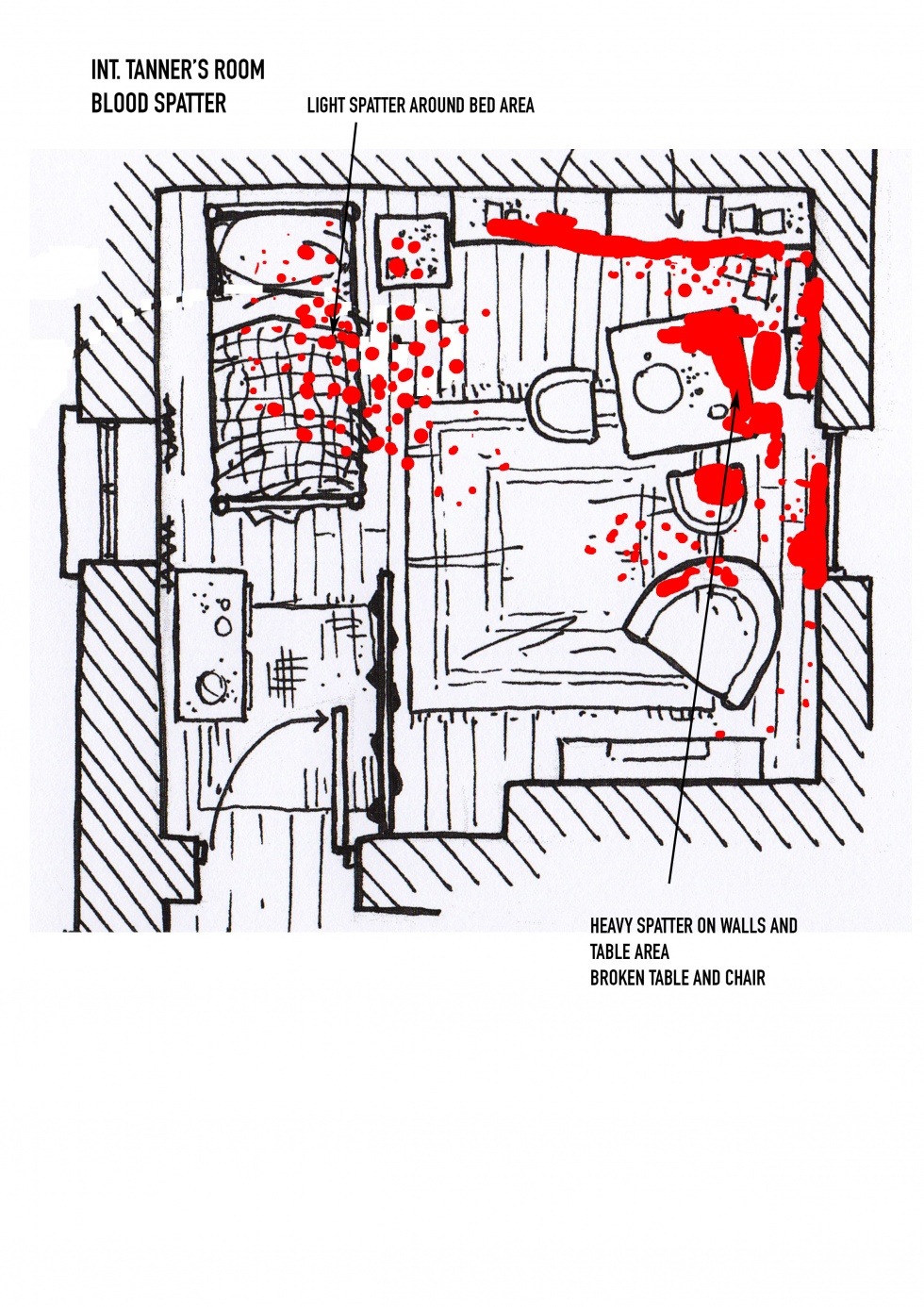 DAMIAN: What has been the most challenging set or scene to design?
DAMIAN: What has been the most challenging set or scene to design?
STEPHEN: Er, um… Wow. That’s a good question. Can I come back to you?
You’d be surprised really. Sometimes it’s the smallest thing.
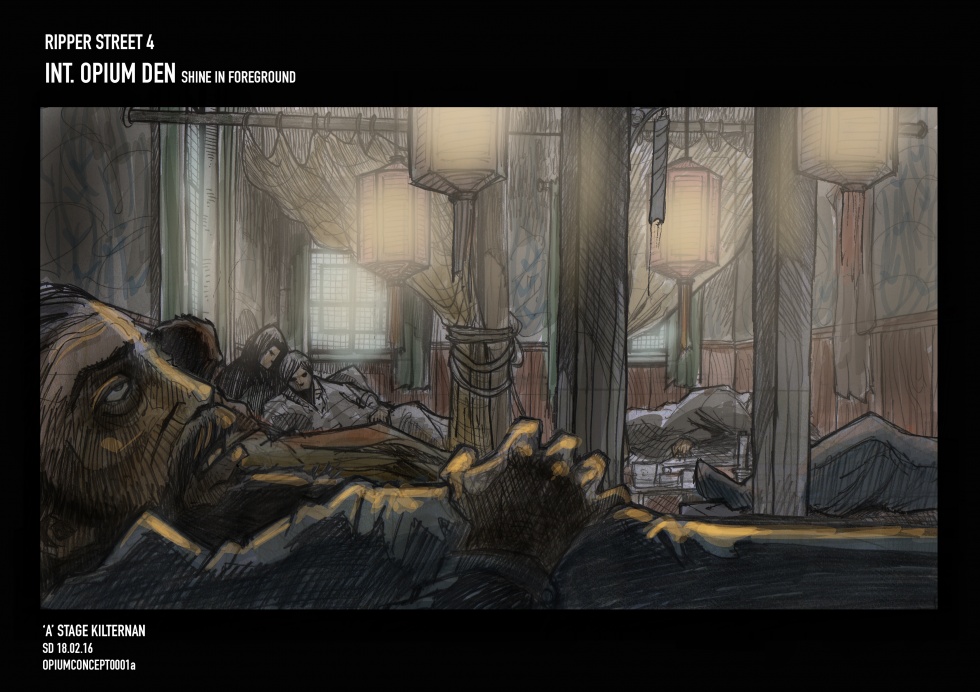 DAMIAN: Is there a sense of sadness once the shoot has wrapped and the sets start to be dismantled?
DAMIAN: Is there a sense of sadness once the shoot has wrapped and the sets start to be dismantled?
STEPHEN: Yes and no. I’m not remotely precious about the sets. The job is to get them on camera and make a film after all.
What I really worry about is not getting ‘that shot’ on the day of the shoot. I always have a key wide angle in my head and will usually draw a concept piece showing this angle. I’ll try to harp on about it ad nauseam so the director will be shamed into doing it. If I look at the rushes and it’s not there, then that’s when I feel sadness. Usually by the end of the shoot, I’m the first guy in line with a sledgehammer.
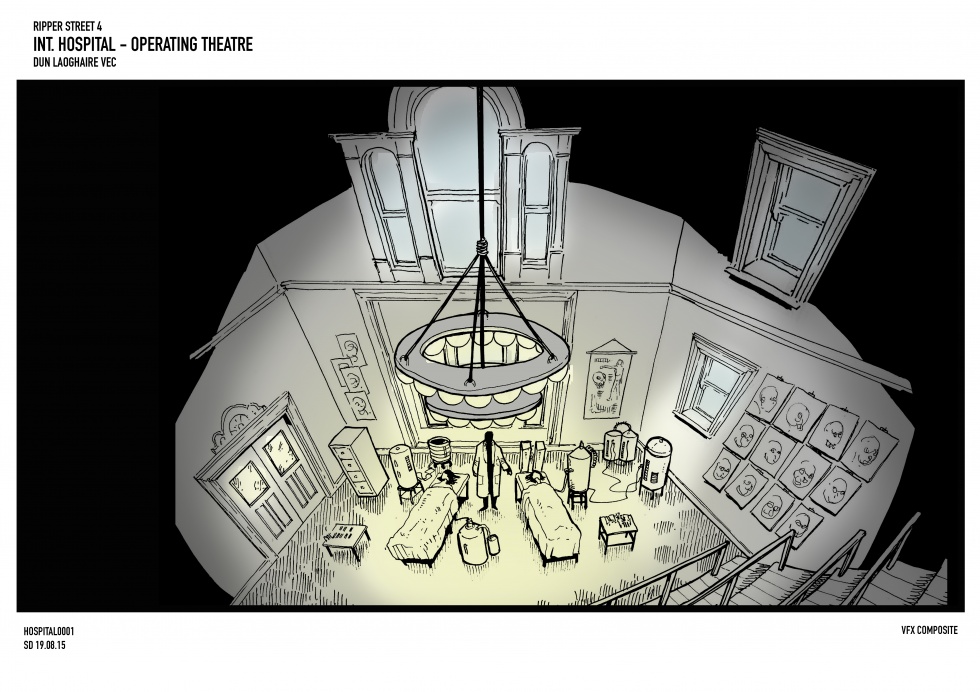 DAMIAN: What happens to these sets – surely they don’t just get thrown away?
DAMIAN: What happens to these sets – surely they don’t just get thrown away?
STEPHEN: Yes, they do.
DAMIAN: And finally, you’re currently working on another epic period drama, also made by Tiger Aspect, what have been the main challenges in the production design for series four of Peaky Blinders?
STEPHEN: Peaky is a great show. I’ve always been a fan and it’s great to work on.
I’m the third designer on the show, so the main challenge is keeping the right feel that has been established, and also doing what I want to do.
Peaky, to use a silly cliche, boxes way above its weight. Ripper did too, so I knew what I was letting myself in for. I shouldn’t talk budget too much really, but Peaky is very well thought of internationally and sits right up there with other TV shows with far bigger budgets. We shoot a lot on big locations. I think Peaky needs scope and scale. Whereas Ripper was about a small, claustrophobic world of the warrens of Whitechapel, Peaky is about big money, big gangs and a much more broad, open story. So it’s big. So I think of big locations, with lots of depth in the frame. I hope you’ll like it when it comes out. I think the stuff we are shooting this year looks amazing and I’m very very happy with it… Stay tuned.
DAMIAN: Stephen, thank you very much indeed.
STEPHEN: No problem. Thank you!
~~~
All the interviews and articles on this website are original and exclusive and I would ask that the copyright be respected. Therefore, please do not use quotes or any other information contained here without permission. Thank you.
~
Copyright © Damian Michael Barcroft 2017
All images Copyright © Stephen Daly/Tiger Aspect Productions 2016
~


